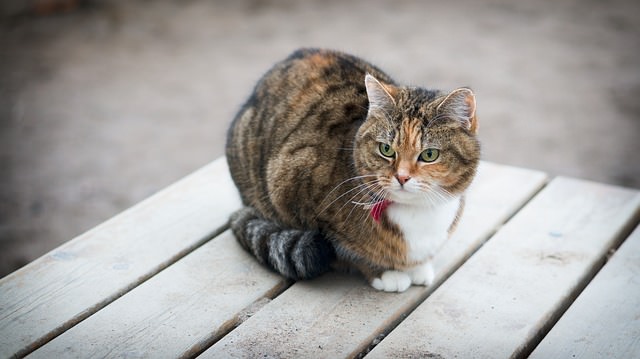As a veterinarian, I have the privilege of seeing cats every day in all stages of emotion. Since I became Fear Free Certified (you can learn more about Fear Free Certified Professionals, click here), more of my feline patients like to see me coming, but I still get the opportunity to see cats in a variety of moods. I observe cats twitching their tails every day, even my own cats do this. Often when I enter my feline exam room, a cat patient will be perched in my window seat with a tail that seems to have a mind of its own. The more movement and excitement happening outside my window with birds and traffic, the more alert the cat seems and the busier his tail can become. Have you ever wondered why cats twitch their tails?
Cats can use their tails for practical purposes, like helping them balance, but even when they are not climbing or moving, they can still use their tail. This other use of the tail is communication.
Studies have shown that kittens and cats with a tail up posture are amicable and un-aroused1. Mother cats seem to signal to their kittens to follow them using their upright tails. When cats twitch just the tips of their tails, it can mean that they are alert and paying attention, and when cats are hunting, they can wave their tails methodically. Some people have hypothesized that the slow hypnotic tail movements when hunting are designed to mesmerize or distract prey.
Cats thrash their tail firmly when they are feeling threatened, afraid, or aggressive. The tail communication is an even more basic part of who your cat is than his physical characteristics. Even Manx cats (that have little to no tail) show movement at the tail base as their emotions change.
If you see a cat rapidly lashing his tail, it is wise to proceed cautiously. The cat is highly aroused and is likely to try to defend himself. He might also have dilated pupils and laid back ears. A hunting cat or a cat that sees something that he perceives as prey will appear ultra-focused. Not only will his tail be moving, but his ears and eyes will be directed to the object of his attention.
When considered in conjunction with all the other body language signals your cat must use in the absence of a verbal language, a cat lover can surmise a lot about a cat’s emotional state. As a cat family member, you probably witness the comfortable happy raised tail most often, but if you watch your cat (and his body language), you can learn a lot about how to understand “feline-ese”.
Do you love cats and want to know more? Like me on Facebook where I share all kinds of neat animal stories, tips and videos!
- Cafazzo S, Natoli E.The social function of tail up in the domestic cat (Felis silvestris catus). Behav Processes. 2009 Jan;80(1):60-6. doi: 10.1016/j.beproc.2008.09.008. PubMed PMID: 18930121.


